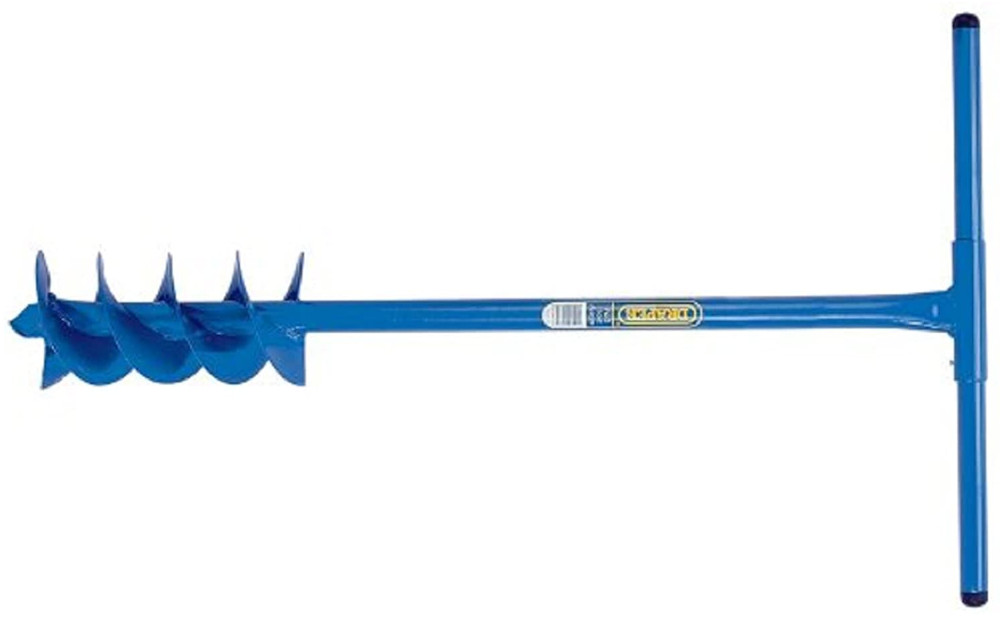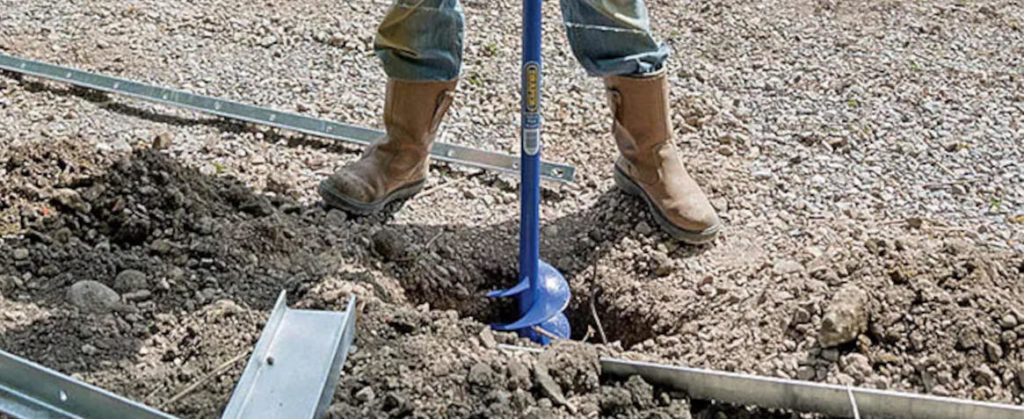Last Updated on March 25, 2024 by Editors
Drilling or digging a deep hole can be an unpleasant process. You want to make sure you choose the best possible garden hand tool for the job. Using manual augers might ensure that. Whether you are deep digging for the first time, or you do so regularly, there are manual augers on the market that will simplify the process.
Digging deep holes in your property is not a simple decision as there is a lot of work involved. When choosing the best manual auger to use for deep holes, there are many things to take into consideration.
Our suggestion for tight budgets:
Draper 24414 Fence Post Auger, 1050 x 150mm

As you will read below we are not so fond of using manual augers that have a helical spiral head to make deep holes. However, the 24414 Fence Post Auger from the Draper brand is not a common spiral manual auger. It is a simple and efficient hand tool that is made from tubular steel (hollow and very strong steel shaft) with a handle and a 5.9-inch diameter auger drill/screw. Additionally, it has a total length of over 41 inches! Another advantage of this auger is that you can remove its T-handle. With this budget-friendly manual auger, you can drill round holes large enough for a 4×4 inch post and up to 3 feet deep without extending its shaft.
Check latest priceTable of Contents
What is a manual auger?
The manual augers are post hole diggers with a T-shaped handle, a head that is a drill or two vertical blades, or an open head. These tools have a long shaft that is in between the handle and the head.
What are manual augers used for?
You use these garden tools to make post holes in the ground. This kind of hole is deep, narrow, and straight. The manual auger is sometimes called a manual auger post-hole digger or manual earth auger. Like every garden hand tool, manual augers are operated manually.
Where to use a manual auger
You can use them in your garden or yard to make holes for planting or for shrubs, to plant stakes or poles. If you have to make a few holes for deck footings, manual augers will help you with that as well. In addition, you might want to drill some holes in the ground for fence posts. Of course, they are one of the best tools to make holes for posts because they are post hole diggers.
Do you want to insert fertilizer or organic matter into your soil to improve it? With these post-hole diggers, you can make narrow and deep holes. Also, making holes for soil aeration is another good use of manual augers. Lastly, other uses of such tools are for soil research and even geological surveys.
Styles of manual augers
Generally, there are two styles of manual augers. The first has a head with two blades or an open head. The second is a drill. It has a helical spiral head. In addition, there are few manual auger sets.
All of these styles of manual augers are very good for augering and making holes in sandy or loose soil. Also, the holes that they make are perfectly round in shape.
Unfortunately, both cannot operate well when the soil has big roots or rocks, especially the one with the spiral-type head. Moreover, the spiral-type of manual augers for home use will not work well in the case that the soil is not dry because the soil tends to stick to the spiral head. They work best when they are drilling holes into moderately cohesive soils like sandy soils. Soil augers of the first style are more versatile. They work well in most types of soil.
1. Manual augers with an open head or two vertical blades
The classic type of manual auger has an open head or a head with two vertical blades that are joined. The soil augers with the open head are called Edelman augers. Both post-hole augers of the first style remove cylindrical plugs of soil.
In some models that have a head with two vertical blades, you can adjust the width of the head by pulling apart or moving closer these two blades. By adjusting them you can control the diameter size of the hole you want to dig. In other models which have the open head, you can replace the head with another one that is more appropriate for the soil you dig.
For example, if you have to dig into a very cohesive soil like clay you can replace the open head with a narrower one (for an added cost, unfortunately) which is better for digging into clay soil. Most models of this style of manual augers that you can find at online retailers are made by the Seymour brand (Seymour Midwest), Eijkelkamp, and AMS. These brands are the most reliable post hole digger and manual auger brands when it comes to all-around efficiency.
Another good thing with this style of the auger is that you can use them to dig even into moist clay soils. Some of them do not have very long shafts. However, it is easy to appreciate that you can buy an extension or a metal pipe, attach it easily to the digger tool and dig even deeper. In addition, there are some telescoping augers on the market. You can extend their shaft to dig up to 8 feet deep holes.
2. Spiral manual augers
The manual augers of the second style have a head that is a spiral-type drill and works like a screw. Typically, manual augers with a drill head have a shaft that has only a length of 2 feet. Generally, they are small post-hole diggers for plants or small posts. This is the main reason why they are only good for making swallow holes. In order to make a little deeper hole with this style of manual auger you have to make a hole wide enough to accommodate the T-shaped grip.
However, like in the case of the first style of manual augers, you can also extend the length of the shaft in some models of this style of garden augers.
3. Auger sets
These sets are made for archeologists or agricultural professionals mostly. They are all-in-one solutions. Usually, these sets contain at least four heads, stone catchers, a handle, a shaft and many shaft extensions, and some goodies like measuring tapes with sound devices, probes, and maintenance tools.

How to use a manual auger
Picture this: You want to dig holes in the ground to set posts that will support a sturdy structure for your outdoor dining set with swivel chairs or your new outdoor high-top bistro set. It’s true that the manual auger is a bit difficult to use at first and it can still be pretty uncomfortable and tiresome, depending on how often you exercise physically. However, with practice and proper preparation, you will manage to make good and deep holes without much hassle.
If you are using a manual auger for the first time, allow some time for breaks. Once you get some experience under your belt it will become a lot easier. The key is to start slow and have a few other tools that will assist you during digging or drilling.
Preparation
A general rule when making deep holes is to make absolutely sure that there are not any utility lines or pipes underground. If you are going to make holes, especially deeper than two feet, you will have to call the 811 utility-locate hotline a few days before. After that, mark the area where you are going to make the hole. If there is any grass on the surface then use another garden hand tool to remove it and make a small hole.
Operation
- Hold the grips of the T-shaped handle with your hands.
- Put the manual auger in the hole.
- Twist and turn the handle clockwise while pressing the tool downwards.
- Lift the auger and remove the soil.
- If it is stuck because of rocks, then turn it counterclockwise and then clockwise to continue.
- Repeat step 1 until the hole is about 2 feet deep. Then extend the shaft or attach the extension and continue from step 1.
If you are digging into hard clay soil with a manual auger you can use water to soften the soil.
You will have to use a jackhammer if you hit solid rock. It is the best tool to blast through it.
What else do you need when you use these digging tools?
When you make narrow holes in the ground a digging bar is the best tool to have. With the digging bar, you can loosen hard soil and dislodge rocks. Moreover, if the bar has a chisel head, you can use it to chop away the roots that your manual auger could not cut.
Another hand tool that is good to have with you is the manual post-hole digger. It will help you to extract the roots and large stones out of the hole. Also, you can use it to dig into tough soil.
Also, it is very helpful to have with you a tape measure to measure the depth of the hole.
What else to consider when choosing the best manual augers?
There are a few more considerations when you choose a manual auger. In our opinion, the main one is the cost of these digging and drilling tools. They tend to be rather expensive for the average homeowner.
The general design of the digging tool
Many manual augers have a fixed length. Their head is welded to the steel shaft, which is then welded to the handle. This means that you can not extend their length without doing a heavy do-it-yourself modification.
For some ground augers you can attach to them a pipe or a shaft extension, replace their handle, or attach other auger heads. For example, you can find on the market separate heads that you can attach. There are auger heads for fine gravel and coarse gravel soils, for clay, sand or coarse sand, or very soft soils.
Other models have a telescoping shaft. With these earth augers, you can extend their length up to 8 feet.
Handles
Typically, all the handles are T-shaped and made of wood or steel. However, there are few ergonomic handles. These ergonomic handles are also T-shaped but are not completely straight. They are curved for more convenience when making holes.
Most of the time, the handles have some anti-slip rubber grips. We suggest you buy bike grips and place them into the two sides of the handle if they don’t have any. Additionally, there are handles with a ratchet mechanism which is extremely comfortable to use. When you use this type of handle you experience a lot less discomfort on your shoulders, wrists, and elbows.
Other metal parts
Among the most common metal materials used for manual augers are carbon steel, stainless steel, and chromoly steel. Chromoly steel is an expensive alloy that contains chromium and molybdenum. It is stronger, harder, and has better corrosion resistance than carbon steel.
Manual auger price
Typically, manual augers are almost all metal tools. The more metal used to make them the more expensive they are. For example, a tool with a handle made of chromoly steel will be a lot more expensive than a soil auger with a wooden handle. Moreover, if it has an extension made of chromoly steel then its price skyrockets.
Maintenance tips
If you want to ensure maximum performance and life of the manual auger then you have to keep it clean and lubricate its metal parts often. Use gloves when you are cleaning it because it has sharp edges. Use water to clean the soil from the garden tool and use a thick cloth to dry it well.
Make sure that you remove all the moisture from the manual auger and oil the metal parts. If the handle of your tool is wooden then apply some linseed oil to finish it when needed. If the soil auger is not a welded one, check the screws, etc. that connect the parts of this digging tool on a regular basis.
Store your manual auger in a dry place like your outdoor storage cabinet or your garage. Remember to oil the metal parts of this aeration tool prior to putting it away before winter. For safety reasons, keep it away from children.
In summary
A manual auger is not just a good idea for landscape contractors and other professionals but also for homeowners. Using a good manual earth auger will help to drill or dig holes in the ground while not exerting much force.
When picking the best manual auger to make deep holes, you want one that is going to have a head with two vertical blades or an open head, instead of a helical screw head, especially if you live in an area where the soil isn’t mainly sandy. A great choice is to buy one whose parts are not welded together and has a handle with a ratcheting mechanism.
As an Amazon Associate I earn from qualifying purchases. We may get commissions for purchases made through links in this post.

